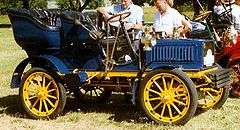Pope-Toledo
| Pope-Toledo | |
|---|---|
 | |
| Overview | |
| Production | 1904–19 |
| Body and chassis | |
| Body style | roadster, tourer |
| Powertrain | |
| Engine | gasoline |
The Pope-Toledo was one of the makes of the Pope Motor Car Company founded by Colonel AA Pope, and was a manufacturer of Brass Era automobiles in Toledo, Ohio between 1903 and 1909. The Pope-Toledo was the most expensive of the Pope range and was the successor to the Toledo of the International Motor Car Company. In 1909 the company was taken over by Richard D. Apperson of the American National Bank of Lynchburg, Virginia (and no relation to Apperson of Kokomo).
History


The 1903 Pope-Toledo was a four-wheel, front-engined, two-seater open car. It was powered by a straight 3 cylinder 182 cubic inch (2983 cc) engine with the then unusual feature of a detachable cylinder head. Valve operation was mechanical and the engine speed was governed at 600RPM. Drive was through a 3-speed gearbox with chains to each rear wheel. The chassis was mainly wood with a steel sub-frame carrying the main mechanical components. The car had a wheelbase of 7 feet 5 inches (2.26 m) and a track of 4 feet 8 inches (1.42 m).
It was entered in the first Vanderbilt Cup (1904), but lost its steering and hit a tree.[1]
The 1904 model was a larger touring car. Equipped with a rear entrance tonneau body, it could seat 5 passengers and sold for US$3500. The vertically mounted water-cooled straight-4, situated at the front of the car, produced 24hp (17.9kW). A 3-speed sliding transmission was fitted. The channel steel-framed car weighed 2350lb (1066kg). This modern Système Panhard car had spark and throttle levers on steering wheel, a novelty at the time.
In 1905, a Pope-Toledo owned by C. Edward Born was driven 828.5 miles before a crowd of 15,000 to win the world's first 24-hour endurance race in Columbus, Ohio. Piloted by brothers George and Charles Soules, the car was protested by runners up as being a special factory-owned "ringer". This protest was rejected by the Columbus Driving Park officials.[2]
By 1907 the company models included limousines and seven seat cars.
References
- ↑ P. Roberts (1973). A Picture History of the Automobile, Ward Lock Ltd, London, UK. ISBN 0-7063-1301-1.
- ↑ Knapp, Michael (1979). "The World's First 24-hour Automobile Race". The Columbus Dispatch. Retrieved 2014-08-10.
- Frank Leslie's Popular Monthly (January, 1904)
- Kimes, Beverly Rae and Clark Jr, Henry Austin. Standard Catalog of American Cars: 1805-1942. (Third Edition). Iola, WI: Krause Publications. 1996.